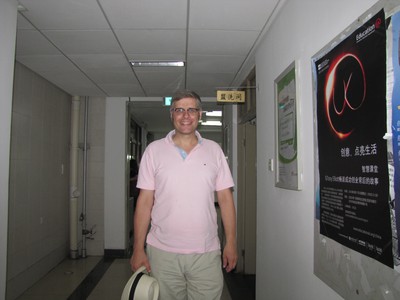Excursion on Peking University campus
On Saturday, we made an excursion on Peking University Campus. There were a lot of people there, who paid to get in, for this is a famous campus. With my professorial ID card, we were able to cut the line and get in for free (after I explained in Chinese that they are my children and my aged mother). We had a very pleasant walk in the most beautiful places on campus.
Hjalmar and Elsa by the Weiming Lake. Note the marble boat on the other shore.
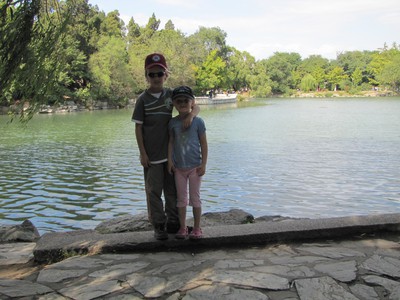
Hjalmar and Elsa fed old bread to the fish from a bridge close to the West gate of campus.

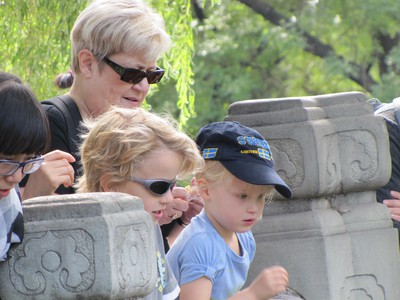
A pillar from the emperor's old summer palace.
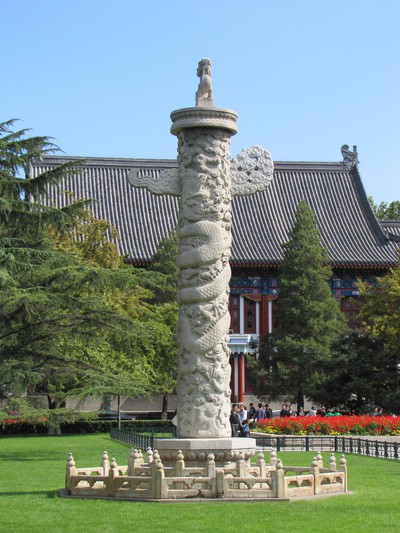
And a statue of Cervantes.

As always, people wanted to photograph the children together with their own children. Elsa is happy to model, while Hjalmar thinks it is "boring." Actually, today two college students (from another university) wanted to be photographed together with me! That was unusual, but I think they used flattering me as a way of getting Elsa into the picture. They were very impressed that I teach at PKU, but did not seem to think Yale is particularly noteworthy.
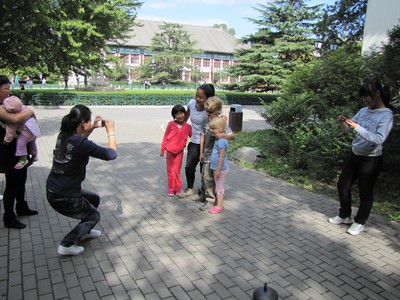
Hjalmar and Elsa by the Weiming Lake. Note the marble boat on the other shore.

Hjalmar and Elsa fed old bread to the fish from a bridge close to the West gate of campus.


A pillar from the emperor's old summer palace.

And a statue of Cervantes.

As always, people wanted to photograph the children together with their own children. Elsa is happy to model, while Hjalmar thinks it is "boring." Actually, today two college students (from another university) wanted to be photographed together with me! That was unusual, but I think they used flattering me as a way of getting Elsa into the picture. They were very impressed that I teach at PKU, but did not seem to think Yale is particularly noteworthy.

Local market
On Friday, we went to a local market, where we bought dates, walnuts, and other nuts. The kids got equipment to make soap bubbles, and I and my mother bought a lot of tea.
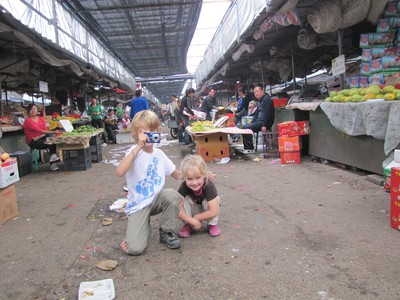
Elsa learnt to drink tea in an elegant Chinese fashion in the tea store. She really likes tea.


Elsa learnt to drink tea in an elegant Chinese fashion in the tea store. She really likes tea.

Exercise inside the compound
Within the compound where I live, there is a small square. There are shops there, including the place from where I get my huge bottles of clean water. But there are also some exercise machines, that are meant for grown-ups, but the kids like them.

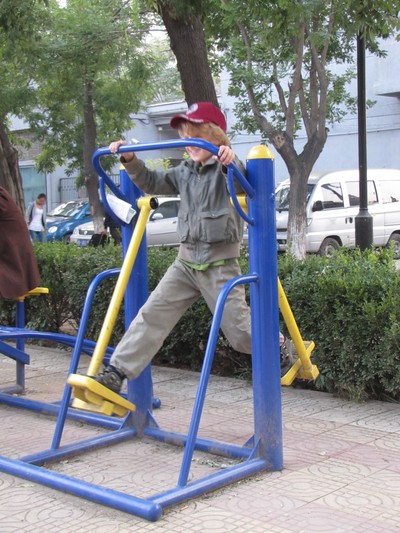


Master photographer Hjalmar shoots photo model Elsa
Hjalmar likes to snap photos and Elsa likes to pose.
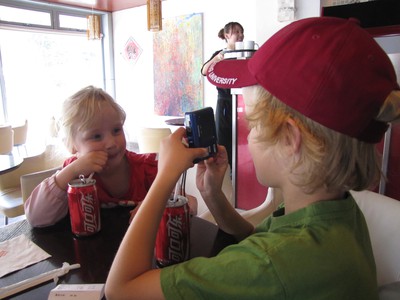

Subway to grandma's shopping
On Thursday, we took the subway to the eastern parts of town so that grandma could do the shopping she has been craving.
In the subway of Beijing, children under 120 centimeters ride for free. Elsa measured in under 120, while Hjalmar, who is tall and handsome, got his own subway card
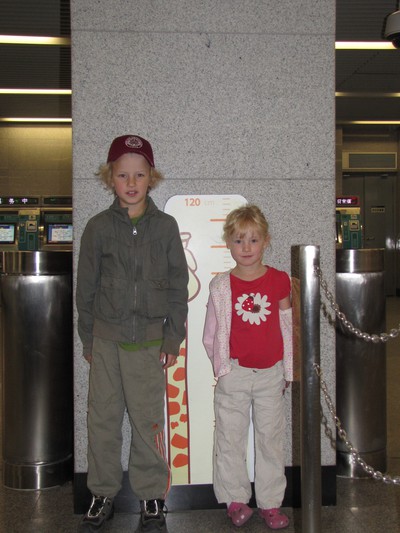
These Chinese toys were a hit, and could be used on the subway as well.

Elsa, grandma, and our friend Stella, who helped us to shop. Note how clean and pleasant the subway cars are!


The shopping team.
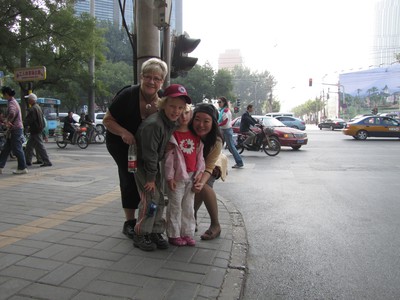
In the subway of Beijing, children under 120 centimeters ride for free. Elsa measured in under 120, while Hjalmar, who is tall and handsome, got his own subway card

These Chinese toys were a hit, and could be used on the subway as well.

Elsa, grandma, and our friend Stella, who helped us to shop. Note how clean and pleasant the subway cars are!


The shopping team.

Hjalmar, Elsa, and my mother in Beijing!
The kids arrived with their grand-mother in good order today to Capital Airport in Beijing, and I was there to pick them up. We went in two taxis home, went out and had lunch, and then the travelers got to rest while I taught my last class before our National Day holiday (lasting eight days!).
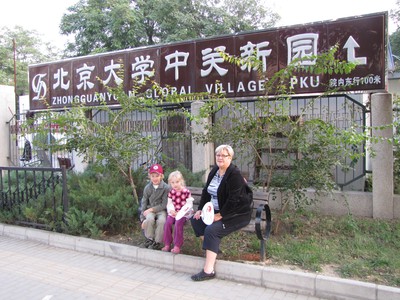
In the late afternoon, we walked to the university campus, where there was an international event. International students had set up booths for their own countries. We met some Swedish students, who had put up a Swedish booth (complete with portraits of the Crown Princess, Northern lights, and Drottningholms castle). I was curious about the North Korean booth, at a safe distance from South Korea!

Hjalmar and Elsa enjoyed the posters in the Swedish booth, to the degree that Hjalmar photographed them.

But what really was interesting was how fascinated people were by the children, perhaps especially Elsa. People are apparently not used to anyone that light-colored, and many, many came forward to tell her how beautiful she is (in Chinese and English!). Many, many wanted to photograph both of the kids as well. But they are, of course, very beautiful.
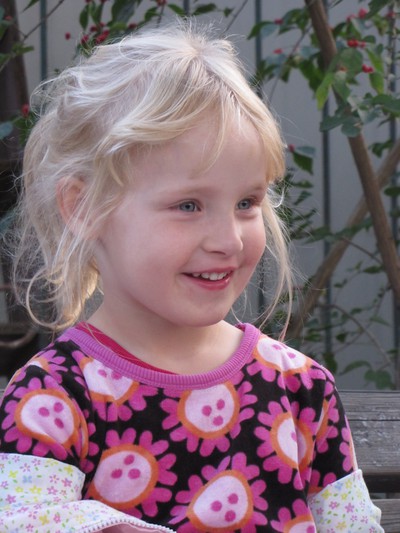
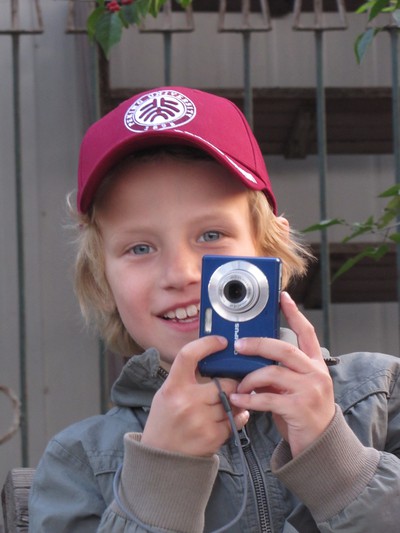
I lent Hjalmar my small camera, and he enjoyed taking a lot of photos.
In the evening, we went to a very good restaurant with Hanzhou food (where my friend, Professor Peng brought me to dinner a few weeks ago). We had a very good meal; the pork and the noodle soup attracted us especially. The same thing happened here: the waitresses (and an occasional waiter) really liked Elsa. At one point we counted nine waitresses who looked at her. Most of them came forward to tell us how beautiful she is. One of them took a special liking to Elsa, spoke a lot with her (this waitress spoke no English at all).
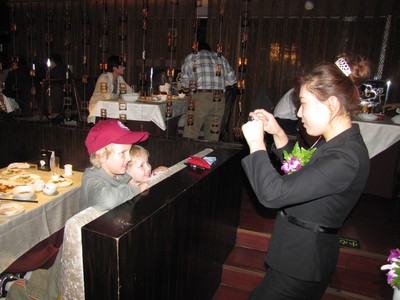
There are different ranks of waitresses at the restaurant, and some of them wore tiaras. She lent it to Elsa, who was absolutely delighted.
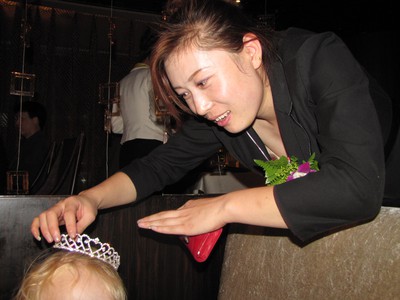
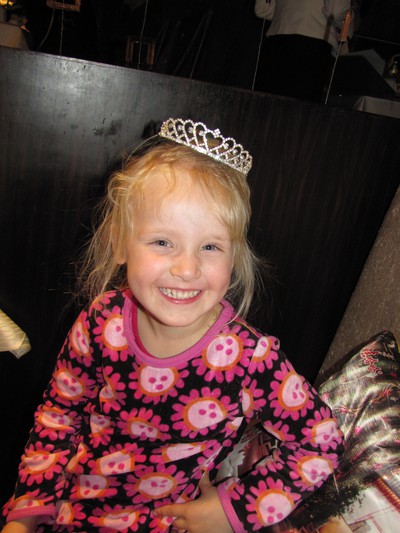

In Hjalmar's camera I found this picture of us dining.

And a very good portrait of his grand-mother.
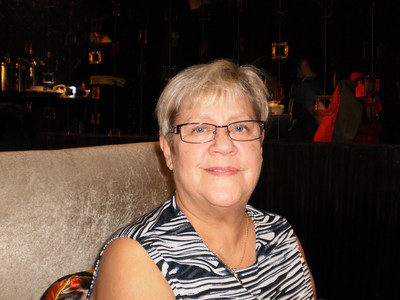
Hjalmar is a very good photographer.
He was also interested in the décor of the restaurant. Especially two large statues.
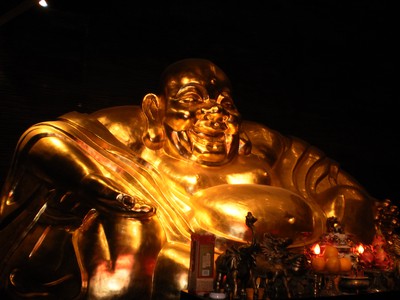


In the late afternoon, we walked to the university campus, where there was an international event. International students had set up booths for their own countries. We met some Swedish students, who had put up a Swedish booth (complete with portraits of the Crown Princess, Northern lights, and Drottningholms castle). I was curious about the North Korean booth, at a safe distance from South Korea!

Hjalmar and Elsa enjoyed the posters in the Swedish booth, to the degree that Hjalmar photographed them.

But what really was interesting was how fascinated people were by the children, perhaps especially Elsa. People are apparently not used to anyone that light-colored, and many, many came forward to tell her how beautiful she is (in Chinese and English!). Many, many wanted to photograph both of the kids as well. But they are, of course, very beautiful.


I lent Hjalmar my small camera, and he enjoyed taking a lot of photos.
In the evening, we went to a very good restaurant with Hanzhou food (where my friend, Professor Peng brought me to dinner a few weeks ago). We had a very good meal; the pork and the noodle soup attracted us especially. The same thing happened here: the waitresses (and an occasional waiter) really liked Elsa. At one point we counted nine waitresses who looked at her. Most of them came forward to tell us how beautiful she is. One of them took a special liking to Elsa, spoke a lot with her (this waitress spoke no English at all).

There are different ranks of waitresses at the restaurant, and some of them wore tiaras. She lent it to Elsa, who was absolutely delighted.



In Hjalmar's camera I found this picture of us dining.

And a very good portrait of his grand-mother.

Hjalmar is a very good photographer.
He was also interested in the décor of the restaurant. Especially two large statues.


Work in the University library
Today I worked both before and after my class (10.10-12.00) in the University library of PKU. It is housed in a beautiful building at the center of campus. As is appropriate, since the library is one of the most central institutions in a university.
It is a great library. But it has some oddities, such as strange opening hours: Closed all of the National Day holiday, which is coming up on Friday and one week afterwards, strange lunch closings of some departments for an hour and a half every day. One would think with PKU's ambition to raise in the rankings of the world's universities that the powers that be would be a little more concerned about getting the library to operate as a first-rate modern library.

The collection of books in medieval history is a respectable one, at least as long as one stays with good books in English (and Chinese, I suppose, but I have very little competence to pass judgment on that). There is a selection of good books in other languages as well, but much fewer than English. Here is a glimpse of some medieval shelves. One recognizes (in burgundy) four very well used volumes of the New Cambridge Medieval History.

After my class, I had lunch with one of my students in the student dining hall, and she took this picture of me. The dining hall serves great food at amazing prices. And everything is made from skratch, not from prefabricated stuff as at Yale.

It is a great library. But it has some oddities, such as strange opening hours: Closed all of the National Day holiday, which is coming up on Friday and one week afterwards, strange lunch closings of some departments for an hour and a half every day. One would think with PKU's ambition to raise in the rankings of the world's universities that the powers that be would be a little more concerned about getting the library to operate as a first-rate modern library.

The collection of books in medieval history is a respectable one, at least as long as one stays with good books in English (and Chinese, I suppose, but I have very little competence to pass judgment on that). There is a selection of good books in other languages as well, but much fewer than English. Here is a glimpse of some medieval shelves. One recognizes (in burgundy) four very well used volumes of the New Cambridge Medieval History.

After my class, I had lunch with one of my students in the student dining hall, and she took this picture of me. The dining hall serves great food at amazing prices. And everything is made from skratch, not from prefabricated stuff as at Yale.

Excursion to Beijing Center for Chinese Studies
Friday is excursion day in the Yale-PKU program. Ningping organizes all kinds of pleasant and instructive excursions to various places around Beijing. Today we were meant to go to two libraries, the Beijing Center for Chinese Studies and the Chinese National Library. Both essential places for anyone who wants to study China seriously, or to study seriously in China. So it was disappointing that only three students (our of seven) indicated that they were interested in going. Even more disappointing when Ningping was waiting on the subway platform (our usual meeting spot) and the only one who actually came was I. It is rather pathetic, in the first place, that they are not more interested in serious study, but it is almost unforgiveably rude first to say that you will come and then not come without leaving any clear message to that effect. Something that I believe is all too common in the present generation of students, having been brought up by curling parents. This is rude towards the administrators of the program who go to great efforts to organize useful tours. (In all fairness, I should point out that one of the students, poor thing, was sick and had told us ahead of time.)
In any case, Ningping wanted to go anyway, with only she and I. We had a good time and we learnt stuff that one would have thought should be valuable to students. A very nice employee showed us around the Beijing Center, which aims (and apparently succeeds rather well) at collecting all literature about China in English (why only English? Valuable things are published also in other languages.) They also have a remarkable collection of rare books (in every language) with publications about China since the sixteenth century, plus old maps and old artefacts. A very nice place to visit. I saw a lot of books I know, and it was a good guided tour. If I ever would make reality of my old dream to do research on China, this would be the place to do it.
Afterwards, Ningping and I went to Metro, where I picked up my shopping card (preprinted with my name in Chinese) and also some muesli and wine. We had a great lunch, featuring a delicious cold leg of lamb, Mongol style.
Here I am at the Beijing Center next to a replica of a general from the terracotta warriors in Xian. The replica was made by the museum, so it is very good quality.

In any case, Ningping wanted to go anyway, with only she and I. We had a good time and we learnt stuff that one would have thought should be valuable to students. A very nice employee showed us around the Beijing Center, which aims (and apparently succeeds rather well) at collecting all literature about China in English (why only English? Valuable things are published also in other languages.) They also have a remarkable collection of rare books (in every language) with publications about China since the sixteenth century, plus old maps and old artefacts. A very nice place to visit. I saw a lot of books I know, and it was a good guided tour. If I ever would make reality of my old dream to do research on China, this would be the place to do it.
Afterwards, Ningping and I went to Metro, where I picked up my shopping card (preprinted with my name in Chinese) and also some muesli and wine. We had a great lunch, featuring a delicious cold leg of lamb, Mongol style.
Here I am at the Beijing Center next to a replica of a general from the terracotta warriors in Xian. The replica was made by the museum, so it is very good quality.

Pleasant midday break at Weiminghu
I went to the student dining hall early today to have lunch. Since all students have their lunch break from 12 to 1, the place is enormously crowded between 12 and 12.20. When I came at 11.30, there wasn't even a line, so I could peacefully decide which course I wanted. A nice combo of chicken thigh, green beans, and rice för 7 RMB. That is about 1 dollar, and it was very good. Better value for money than anything you could get in New Haven, obviously, and not to mention Sweden.
Afterwards I went to the bursar's office to fill up my meal card with money. I had prepared a sentence to say, but as so often in China, there is no unnecessary small talk, or any talk at all. Simply a line of students with their cards and money in the hands. At the front of the line, one gives the money to the cashier, puts the card into a machine, takes it out and walks away. Without a single word being uttered by anyone.
Afterwards, I walked down to the lake that is in the middle of the PKU campus. I had luck, for two persons got up from a bench by the water just before I arrived, so I got a seat. I had printed out pages from Alcuins letters from the Monumenta Germaniae Historica website, so I sat there in the very pleasant shade, by the water reading Alcuin in telling the king of Northumbria that the reason for the Vikings' sudden arrival probably was the poor moral state of people in his kingdom, so the king should get them to improve and start with himself. All while I was sipping of a cup of coffee. (Yes, one of my Chinese students on Monday pointed out an American-style café called Paradiso, close to the university library, so now I go there and get a small cup of coffee for 5 RMB when I feel the urge). That was just about perfect, especially since I had some Carrefour dark chocolate to nibble on.
This photo is taken from the bench, so the view is exactly the one I had while reading.
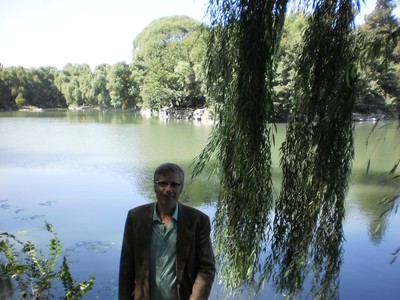
Afterwards I went to the bursar's office to fill up my meal card with money. I had prepared a sentence to say, but as so often in China, there is no unnecessary small talk, or any talk at all. Simply a line of students with their cards and money in the hands. At the front of the line, one gives the money to the cashier, puts the card into a machine, takes it out and walks away. Without a single word being uttered by anyone.
Afterwards, I walked down to the lake that is in the middle of the PKU campus. I had luck, for two persons got up from a bench by the water just before I arrived, so I got a seat. I had printed out pages from Alcuins letters from the Monumenta Germaniae Historica website, so I sat there in the very pleasant shade, by the water reading Alcuin in telling the king of Northumbria that the reason for the Vikings' sudden arrival probably was the poor moral state of people in his kingdom, so the king should get them to improve and start with himself. All while I was sipping of a cup of coffee. (Yes, one of my Chinese students on Monday pointed out an American-style café called Paradiso, close to the university library, so now I go there and get a small cup of coffee for 5 RMB when I feel the urge). That was just about perfect, especially since I had some Carrefour dark chocolate to nibble on.
This photo is taken from the bench, so the view is exactly the one I had while reading.

Hjalmar och Elsa har fått kinesiska namn
I dag har jag gett mina barn kinesiska namn. Såhär kommer de att heta. Först, Hjalmar:
文雅乐 Wen Ya Le. Ya betyder "elegant" och Le betyder "glad".
Och såhär heter Elsa:
文恩飒 Wen En Sa. En betyder "graciös" och Sa betyder "modig".
Wen betyder, förstås, "litteratur, kultur."
Jag tycker namnen passar bra på dem. Hoppas de tycker om dem.
Mamma heter förstås sedan tidigare
文爱娃 Wén Aì Wá. Ai betyder "älskad" och Wa betyder "docka".
文雅乐 Wen Ya Le. Ya betyder "elegant" och Le betyder "glad".
Och såhär heter Elsa:
文恩飒 Wen En Sa. En betyder "graciös" och Sa betyder "modig".
Wen betyder, förstås, "litteratur, kultur."
Jag tycker namnen passar bra på dem. Hoppas de tycker om dem.
Mamma heter förstås sedan tidigare
文爱娃 Wén Aì Wá. Ai betyder "älskad" och Wa betyder "docka".
Opening ceremony for Yale in Beijing
Here is the official group photo of Yale in Beijing. It includes professors and language teachers teaching in the program, the Yale students, their Yuanpei roommates, administrators in the Program and in the International office of PKU.
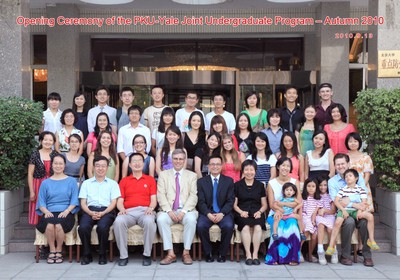

Moon cakes
Today is the mid-autumn festival, the day for eating moon cakes. This is what they look like. I discovered that this one actually has text on it, and I think it says mid-autumn 中秋. The cake has a filling, which is made from different kinds of sweet bean paste.
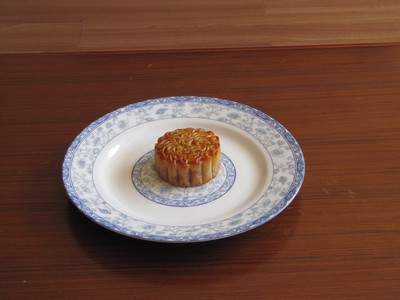
Here is the package in which kind Yuanpei college gave me eight moon cakes. Really too many to eat quickly, especially since I got six more from the International office at PKU yesterday.
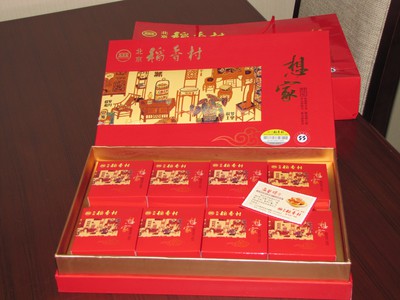

Here is the package in which kind Yuanpei college gave me eight moon cakes. Really too many to eat quickly, especially since I got six more from the International office at PKU yesterday.

Trip to the expat ghetto
A couple of weeks ago, I took the subway to the eastern side of town, where a lot of the expats (foreigners living in Beijing) live, and where there thus are a lot of things that cater to foreigners. Here are some of the things I saw.


This very nice river or canal looked very pretty. Beijing was founded on a couple of small rivers. The city very early ono used up all the water, so there is a lack of water in Beijing, but the government has built enormous aqueducts that lead water from great rivers down south to Beijing. This thing that look like a river must be dammed or something, since it does have so much water.
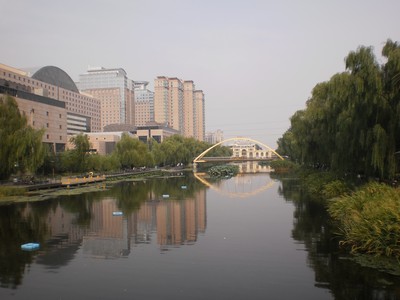


This very nice river or canal looked very pretty. Beijing was founded on a couple of small rivers. The city very early ono used up all the water, so there is a lack of water in Beijing, but the government has built enormous aqueducts that lead water from great rivers down south to Beijing. This thing that look like a river must be dammed or something, since it does have so much water.

Excursion for foreign experts
Wednesday 15 September is a university holiday, for it is the Mid-Autumn Festival. No teaching! (I wish Yale celebrated a mid-autumn festival!) Traditional Chinese festivals follow a lunar calendar, so this means that it will be full moon tomorrow.
To celebrate, the International Office at Peking University invited all foreigners who are teaching at PKU this semester to a wonderful dinner in the New Summer Palace (which is not new, but over a hundred years old). It is a huge park in which the last emperors of China had the palace they lived in during the summer. In the middle of the park is a large lake. There are very pleasant walkways among trees and green areas. Small streams and beautiful bridges.
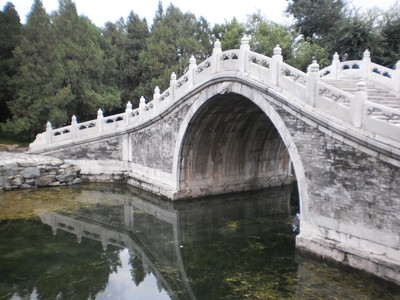
In the lake is the famous marble boat of Dowager Empress Cixi. It is a boat built out of marble! At the end of the nineteenth century China had money to produce a modern navy, which it needed since it was repeatedly defeated by western powers and Japan. Cixi thought the money was better spent building a new Summer palace (after western powers had destroyed the old one as punishment for China) and to build this very expensive marble boat.
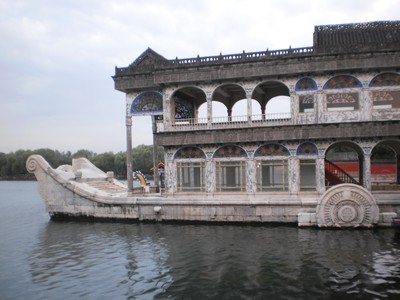
We walked through the park, passed the boat and got to the restaurant, where we were served a splendidly nice meal by servers dressed in traditional dress. The food was very good.

There was also a performance by members of the Peking University Orchestra for traditional instruments. The music was very enjoyable, and the players were very skilled.

After dinner it was time for us to get to ride a boat in the lake, to admire the full moon and the sights in the park. It was a gorgeous evening. We did not get to ride the marble boat, but we started out not far from it.

While we sailed, the players entertained with solo pieces.
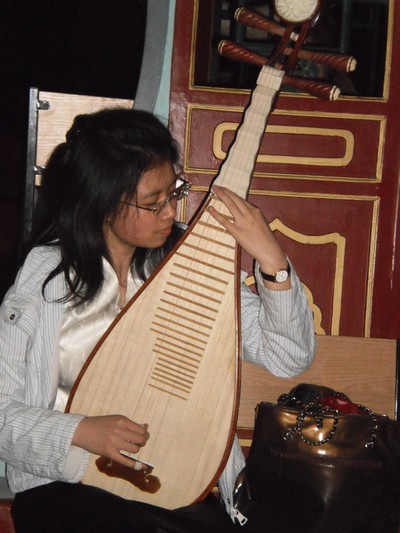
I met a lot of interesting people and talked all evening with them. An Israeli professor of neolithic archeology who now works at Harvard but excavates in China, a former president of the German university of Eichstätt (who knows someone I know from Yale), a doctoral student from the École Normale Supérieur in Paris, a professor of literature from Freie Universität Berlin, a UC San Diego professor of modern Chinese history and others. We had a lot of fun and they were very nice people. Most of them live in the same apartment complex as I, so now we are going to have dinners together.
At the end of the evening, we got a package of very fine mooncakes (the sweet, largeish, filled cookies that the Chinese eat for this holiday). I am eating one right now.
Here I am outside our restaurant.

To celebrate, the International Office at Peking University invited all foreigners who are teaching at PKU this semester to a wonderful dinner in the New Summer Palace (which is not new, but over a hundred years old). It is a huge park in which the last emperors of China had the palace they lived in during the summer. In the middle of the park is a large lake. There are very pleasant walkways among trees and green areas. Small streams and beautiful bridges.

In the lake is the famous marble boat of Dowager Empress Cixi. It is a boat built out of marble! At the end of the nineteenth century China had money to produce a modern navy, which it needed since it was repeatedly defeated by western powers and Japan. Cixi thought the money was better spent building a new Summer palace (after western powers had destroyed the old one as punishment for China) and to build this very expensive marble boat.

We walked through the park, passed the boat and got to the restaurant, where we were served a splendidly nice meal by servers dressed in traditional dress. The food was very good.

There was also a performance by members of the Peking University Orchestra for traditional instruments. The music was very enjoyable, and the players were very skilled.

After dinner it was time for us to get to ride a boat in the lake, to admire the full moon and the sights in the park. It was a gorgeous evening. We did not get to ride the marble boat, but we started out not far from it.

While we sailed, the players entertained with solo pieces.

I met a lot of interesting people and talked all evening with them. An Israeli professor of neolithic archeology who now works at Harvard but excavates in China, a former president of the German university of Eichstätt (who knows someone I know from Yale), a doctoral student from the École Normale Supérieur in Paris, a professor of literature from Freie Universität Berlin, a UC San Diego professor of modern Chinese history and others. We had a lot of fun and they were very nice people. Most of them live in the same apartment complex as I, so now we are going to have dinners together.
At the end of the evening, we got a package of very fine mooncakes (the sweet, largeish, filled cookies that the Chinese eat for this holiday). I am eating one right now.
Here I am outside our restaurant.

Mao in sandstorm
The largest statue of Mao Zedong in the world is in Kashgar. I suppose the great distance from Beijing makes a larger statue necessary.
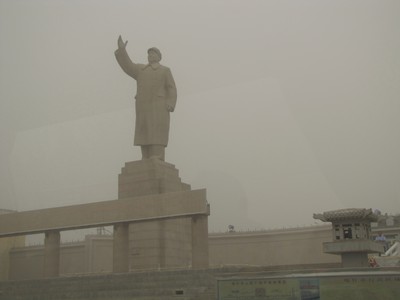

Kashgar livestock market II
More pictures from the livestock market in Kashgar.

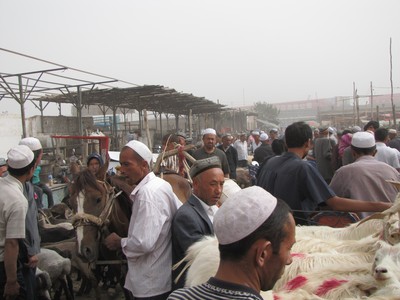
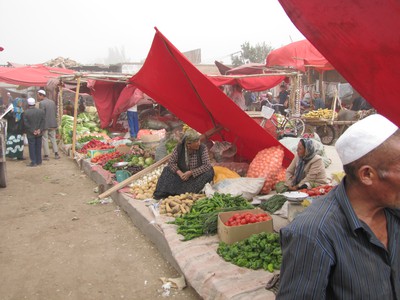
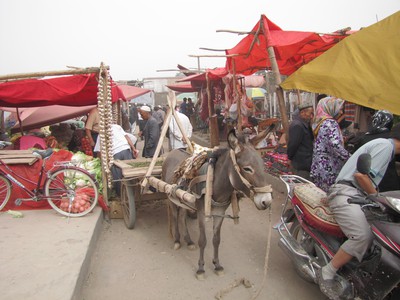
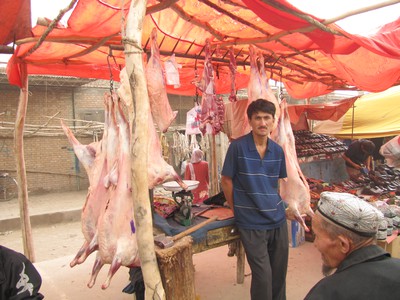







Chilly in Beijing
Fall started yesterday afternoon. It began to rain, and since I did not have my umbrella with me, I got rather wet on the way back form the office. No problem, I changed as soon as I got home. Today (17 September) the rain has continued, but very lightly. It is chilly, about 15 degrees Celsius. I think it is rather nice both with a little cooler temperatures (it was 32 on Monday!) and with a little humidity (Beijing is a very dry place).'
By the way, yesterday I took up my Chinese lessons again. I have a new, very good tutor.
By the way, yesterday I took up my Chinese lessons again. I have a new, very good tutor.
Livestock market in Kashgar
On Sunday 5 September, we visited the famous livestock market in Kashgar. That was really something to see! Amazing.
On the way there, we saw a lot of farmers bringing what they wanted to sell to the market.
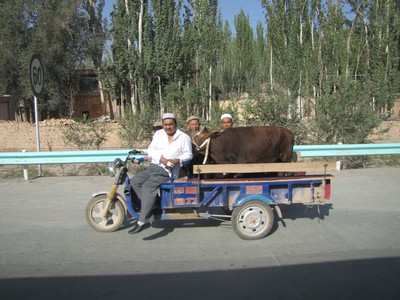


The market itself was divided into sections for different kinds of animals. First came the sheep, who all got to meet a very skilled barber.

Afterwards they were all very elegant.


Goats were also for sale.

As were donkeys, who really made a lot of noise in the way one reads about in children's books.


In the innermost part of the market was the horse market. A lot of things were happening here. I stayed for quite some time to look, while I was thinking of my great grand-father Alrik Johansson, who was a horse trader. I bet that horse markets in Sweden did not look that different in the 1910s from how this one looks.
I guess that this is a seller who is showing his horse to interested onlookers.
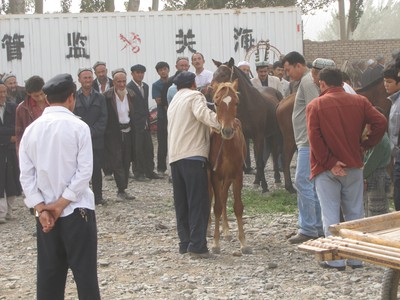
Rather often a guy was riding a horse. I never figured out whether these were sellers demonstrating the abilities of their horses, or buyers who took them for a trial run. They rode fast at any rate. Some of the horses seemed almost untamed. This guy managed well without a saddle.
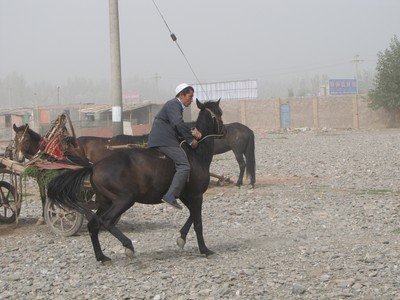
Others were demonstrating the speed of the horses by getting them to run around in this way. This is when I stayed close to a cart in order not to get in the way.
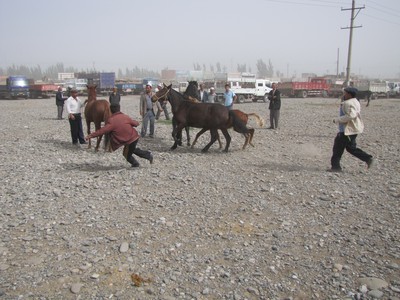
Towards the wall stood groups of elders, who followed everything very attentively. Don't they look as if they are thinking that the horses were better back in the fifties? Not too impressed.

I think this is the handshake that sealed the deal. They were shaking hands for a very long time, and it really looked like one had bought a horse from the other.
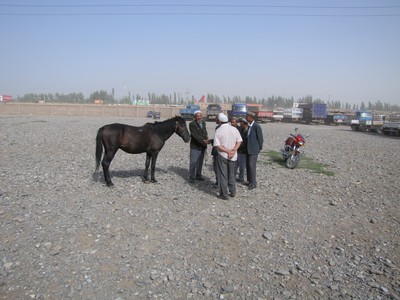
I have more pictures from the Livestock market, but I'll break off here. Notice how nice and blue the sky is in that last photo. That was taken perhaps half an hour before the photo of the old men and the photo of the man riding, in which the distance is rather hazy. The sandstorm that stranded us in Kashgar started while we were at the Livestock market, and I think it started between those two photos. And since I am on the subject, this is what the sand storm looked like. It is in the middle of the afternoon, not at night.
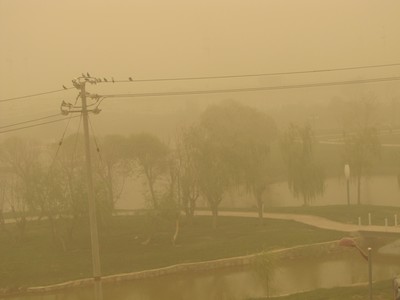
On the way there, we saw a lot of farmers bringing what they wanted to sell to the market.



The market itself was divided into sections for different kinds of animals. First came the sheep, who all got to meet a very skilled barber.

Afterwards they were all very elegant.


Goats were also for sale.

As were donkeys, who really made a lot of noise in the way one reads about in children's books.


In the innermost part of the market was the horse market. A lot of things were happening here. I stayed for quite some time to look, while I was thinking of my great grand-father Alrik Johansson, who was a horse trader. I bet that horse markets in Sweden did not look that different in the 1910s from how this one looks.
I guess that this is a seller who is showing his horse to interested onlookers.

Rather often a guy was riding a horse. I never figured out whether these were sellers demonstrating the abilities of their horses, or buyers who took them for a trial run. They rode fast at any rate. Some of the horses seemed almost untamed. This guy managed well without a saddle.

Others were demonstrating the speed of the horses by getting them to run around in this way. This is when I stayed close to a cart in order not to get in the way.

Towards the wall stood groups of elders, who followed everything very attentively. Don't they look as if they are thinking that the horses were better back in the fifties? Not too impressed.

I think this is the handshake that sealed the deal. They were shaking hands for a very long time, and it really looked like one had bought a horse from the other.

I have more pictures from the Livestock market, but I'll break off here. Notice how nice and blue the sky is in that last photo. That was taken perhaps half an hour before the photo of the old men and the photo of the man riding, in which the distance is rather hazy. The sandstorm that stranded us in Kashgar started while we were at the Livestock market, and I think it started between those two photos. And since I am on the subject, this is what the sand storm looked like. It is in the middle of the afternoon, not at night.

The great mosque in Ürümqi
The great mosque next to the bazar in Ürümqi was an impressive building.
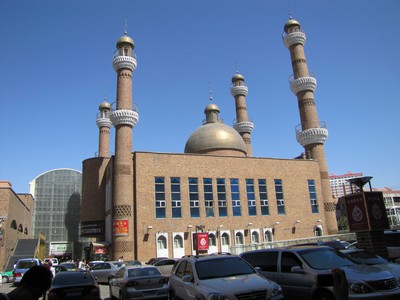
A very tall minaret.

With interesting reliefs.


A very tall minaret.

With interesting reliefs.

Jag idag 15 september
